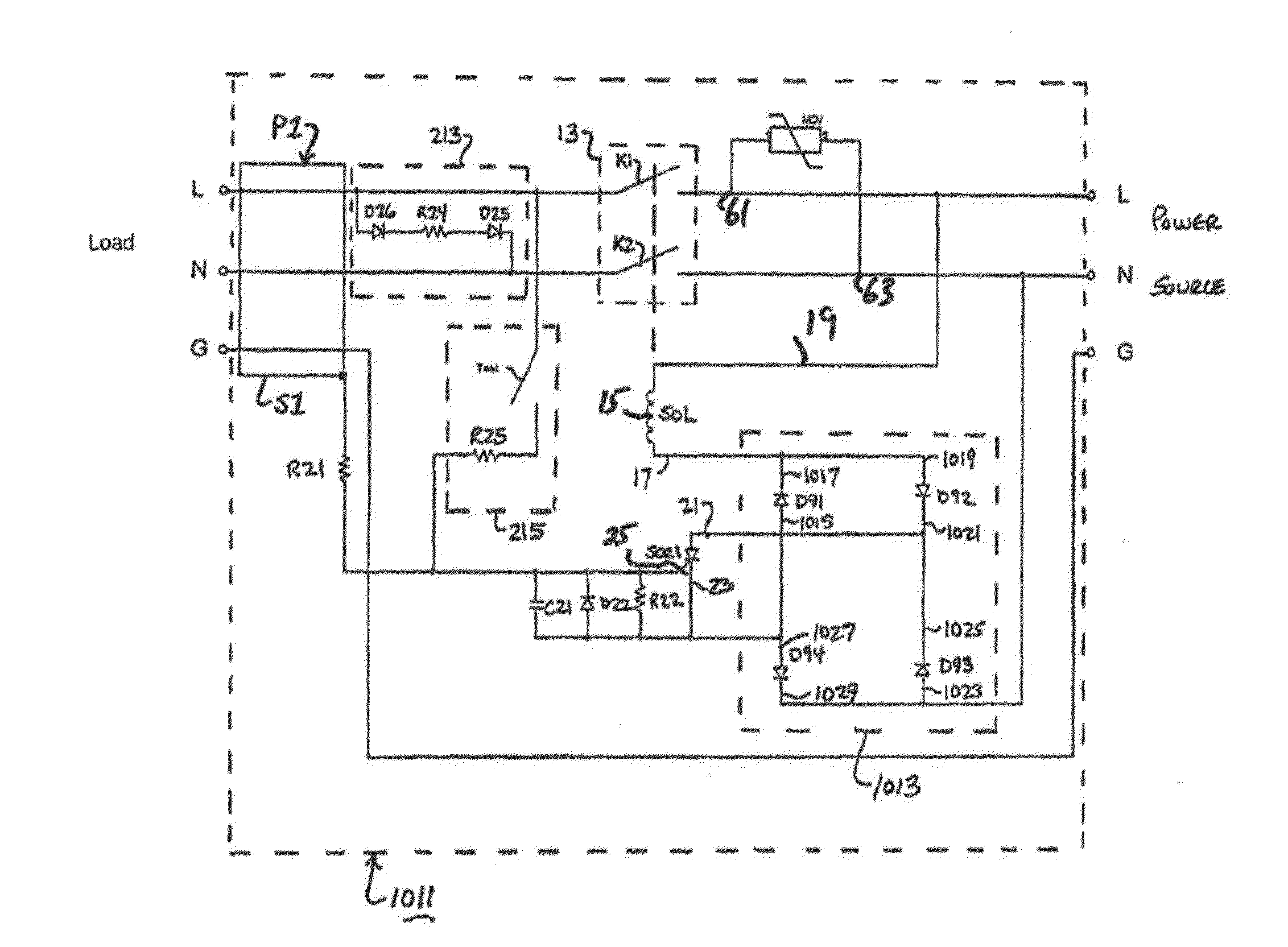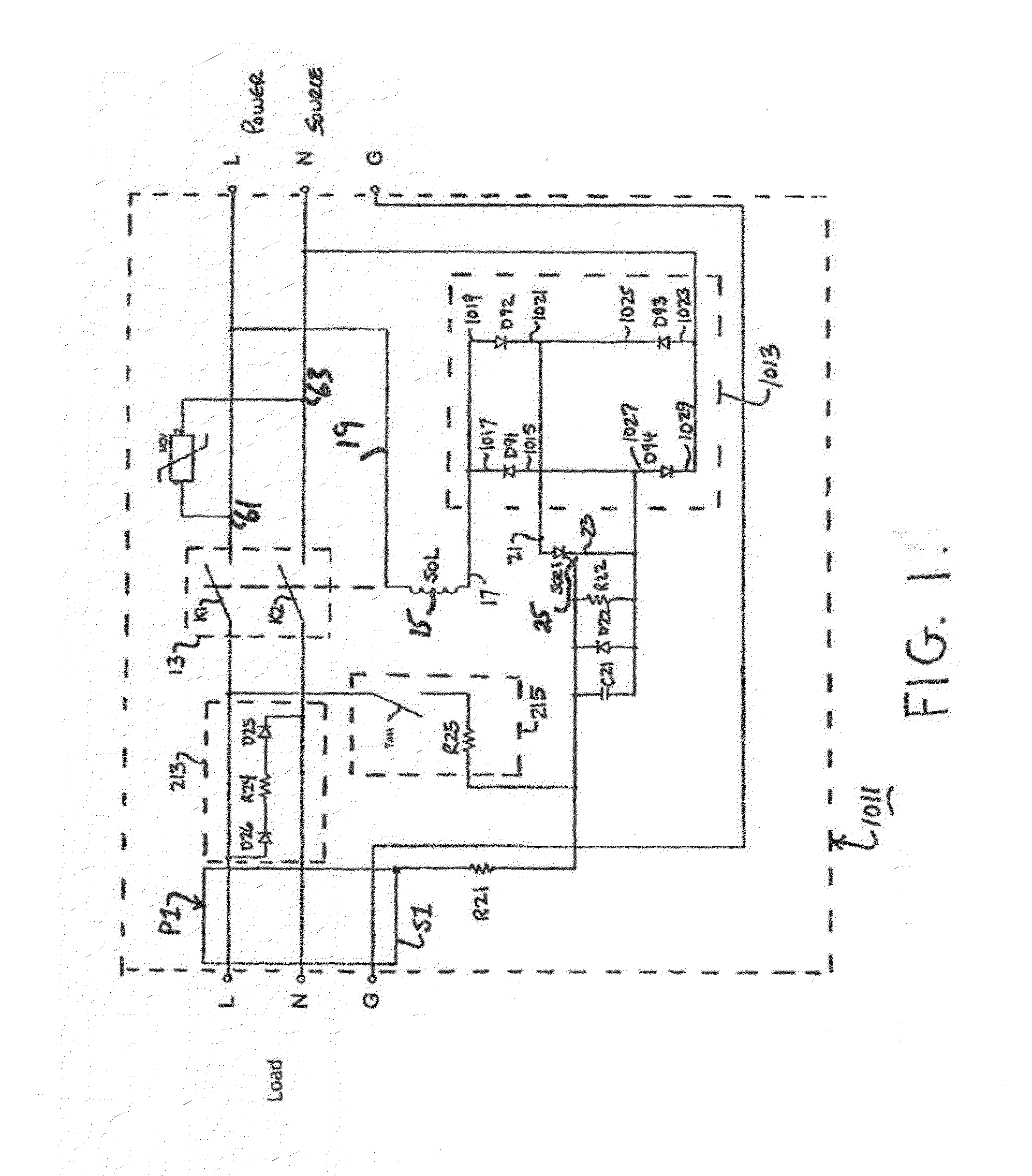Leakage current detection and interruption (LCDI) device with ignition containment features
a leakage detection and interruption technology, applied in the direction of emergency protective arrangement details, electrical devices, arrangements resposes to fault current, etc., can solve the problems of reducing the safety of electrical equipment, reducing the safety of equipment, and reducing the risk of ground fault and grounded neutral conditions in the conductor's conductor, so as to minimize the density of packaging, facilitate assembly, and maximize the distance between components
- Summary
- Abstract
- Description
- Claims
- Application Information
AI Technical Summary
Benefits of technology
Problems solved by technology
Method used
Image
Examples
first embodiment
[0030]Referring now to FIG. 1 there is shown a safety circuit constructed according to the teachings of the present invention, the safety circuit being represented generally by reference numeral 1011. Safety circuit 1011 is designed principally for use as a safety device for a power cable P which connects a power source (i.e., a line) to a load, said power cable P including a power line L, a neutral line N, and a ground line G. Each of the power and neutral lines L and N is wrapped with a metal sheath or other similar type of shielded wrapping.
[0031]The metal sheaths of the power and neutral lines L and N are, in turn, twisted together so as to effectively form a single metal sheath S1 which surrounds power line L and neutral line N. Ground line G remains electrically isolated from power line L and neutral line N.
[0032]As will be discussed in detail below, safety circuit 1011 interrupts the flow of current through power line L and neutral line N extending between the power source an...
second embodiment
[0045]Referring now FIG. 2, there is shown a safety circuit constructed according to the teachings of the present invention, the safety circuit being represented generally by reference numeral 1111. Safety circuit 1111 is identical in all respects with safety circuit 1011 with one notable exception: the power connections for solenoid SOL and the sensing circuitry are derived from the output side the load) rather than from the input side (i.e., the power soure). Specifically, second end 19 of winding 15 for solenoid SOL is connected to power line L at a location between sheath S1 and circuit breaker 13. In addition, anode 1023 of diode D93 and cathode 1029 of diode D94 are connected to neutral line N at a location between sheath S1 and circuit. breaker 13.
third embodiment
[0046]Referring now FIG. 3, there is shown a safety circuit constructed according to the teachings of the present invention, the safety circuit being represented generally by reference numeral 1211 Safety circuit 1211 is substantially similar in construction to safety circuit 1011. The principal distinction between safety circuit 1211 and safety circuit 1011 is that, in safety circuit 1211, solenoid SOL is connected directly to silicon controlled rectifier SCR1 whereas, in safety circuit 1011, solenoid SOL is connected indirectly to silicon controlled rectifier SCR1 through diode bridge 1013. Specifically, in safety circuit 1211, first end 17 of the winding for solenoid SOL is connected to anode 21 of silicon controlled rectifier SCR1 and second end 19 of the winding for solenoid SOL is connected to cathode 1021 of diode D92. Furthermore, diode bridge 1013 is directly connected to the input side (i.e., the power source) of power line L and neutral line N, with anode 1019 of diode D9...
PUM
 Login to View More
Login to View More Abstract
Description
Claims
Application Information
 Login to View More
Login to View More - R&D
- Intellectual Property
- Life Sciences
- Materials
- Tech Scout
- Unparalleled Data Quality
- Higher Quality Content
- 60% Fewer Hallucinations
Browse by: Latest US Patents, China's latest patents, Technical Efficacy Thesaurus, Application Domain, Technology Topic, Popular Technical Reports.
© 2025 PatSnap. All rights reserved.Legal|Privacy policy|Modern Slavery Act Transparency Statement|Sitemap|About US| Contact US: help@patsnap.com



